Investigating the Role of the Local Community as Co-Managers of the Mount Cameroon National Park Conservation Project
Abstract
:1. Introduction
Background of MCNP Conservation Projects
2. Materials and Methods
3. Results
3.1. Community Perception towards Establishing a Strict Conservation Zone
3.2. Community Support of MCNP Conservation Initiative
3.3. Influence of Perception of Tenure, Cost-Bearer and Benefactors on Support of MCNP Projects
3.4. Level of Engagement in MCNP Activities
3.5. Qualitative Results
4. Discussion
4.1. Community Support for the MCNP Initiative
4.2. Ownership, Control, Decision-Making and Project Benefactors
4.3. Local Engagement and Expectations
5. Conclusions
Supplementary Materials
Author Contributions
Conflicts of Interest
References
- Brandon, K.; Wells, M. Lessons for REDD+ from protected areas and integrated conservation and development projects. In Realising REDD+: National Strategy and Policy Options; Center for International Forestry Research (CIFOR): Bogor, Indonesia, 2009; pp. 225–236. [Google Scholar]
- Crider, S.T.; Anaya, S.J. Indigenous peoples, the environment, and commercial forestry in developing countries: The case of Awas Tingni, Nicaragua. Hum. Rights Q. 1996, 18, 345–367. [Google Scholar]
- Change, I.C. The Physical Science Basis: Working Group I Contribution to the Fifth Assessment Report of the Intergovernmental Panel on Climate Change; Cambridge University Press: New York, NY, USA, 2013; Volume 1, pp. 1–535. [Google Scholar]
- Maxime, N.N.L.; Jiwen, G.; Alphonse, N. Assessment of Socioeconomic Factors and Stakeholders Involved in Dzanga Sangha Complex Protected Area, Central African Republic. J. Sustain. Dev. 2010, 3, 273. [Google Scholar] [CrossRef]
- Humphrey, D. Logjam: Deforestation and the Crisis of Global Governance; Earthscan: London, UK, 2006. [Google Scholar]
- Angelsen, A.; Wertz-Kanounnikoff, S. What Are the Key Design Issues for REDD and the Criteria for Assessing Option; Angelsen, A., Ed.; Center for International Forestry Research: Bogor, Indonesia, 2008; pp. 11–21. [Google Scholar]
- Minang, P.A.; van Noordwijk, M. Design challenges for achieving reduced emissions from deforestation and forest degradation through conservation: Leveraging multiple paradigms at the tropical forest margins. Land Use Policy 2013, 31, 61–70. [Google Scholar]
- Hughes, R.; Flintan, F. Integrating Conservation and Development Experience; Biodiversity and Livelihoods; IIED: London, UK, 2001. [Google Scholar]
- Cerbu, G.; Swallow, B.; Thompson, D. Locating REDD: A global survey and analysis of REDD readiness and demonstration activities. Environ. Sci. Policy 2011, 14, 168–180. [Google Scholar] [CrossRef]
- Child, B.; Lyman, M. Natural Resource as Community Asset: Lessons from Two Continents; Sand County Foundation and The Aspen Institute: Madison, WI, USA, 2005. [Google Scholar]
- Child, B. Lessons, Experiences, and Critical Conditions for CBNRM. Can Communities Conservation Bring International Goals Down To Earth; Nordic Council of Ministers: Copenhagen, Denmark, 2007; pp. 36–37. [Google Scholar]
- Gruber, J. Key principles of Community-Based natural resource management: A synthesis and interpretation of identified effective approaches for managing the commons. Environ. Manag. 2010, 45, 52–66. [Google Scholar] [CrossRef] [PubMed]
- Blom, B.; Sunderland, T.; Murdiyarso, D. Getting REDD to work locally: Lessons learned from integrated conservation and development projects. Environ. Sci. Policy 2010, 13, 164–172. [Google Scholar] [CrossRef]
- Moki, S.M. Mount Cameroon Gets a National Park. 2010. Available online: http://www.fakonewscentre.com/mountcameroonpark.htm?andsession-id=d698178ea9a22b7b6ee0b1c6bff9ec57 (accessed on 14 July 2014).
- Movuh, M.C.Y.; Schusser, C. Power, the hidden factor in development cooperation. An example of community forestry in Cameroon. Open J. For. 2012, 2, 240–251. [Google Scholar] [CrossRef]
- Sunderlin, W.D.; Hatcher, J.; Liddle, M. From Exclusion to Ownership? Challenges and Opportunities in Advancing Forest Tenure Reform; Rights and Resources Initiative: Washington, DC, USA, 2008. [Google Scholar]
- Eben, E.S. Prunus Africana Management Plan for the Mount Cameroon National Park and its Support Zone; Regional Delegation of Forestry and Wildlife in Collaboration with the Programme for the Sustainable Management of Natural Resources for the South West (PSMNR-SW) and Local Stakeholders: Buea, Cameroon, 2011; p. 36. [Google Scholar]
- Ingram, V.; Nsawir, A.T. Pygeum: Money growing on trees in the Cameroon Highlands? Nat. Faune 2007, 22, 29–36. [Google Scholar]
- Akoa, A.; Betti, J.L.; Ewusi, N.B.; Mbarga, N.; Akagou, Z.H.C.; Fonkoua, C.; Essomba, E.R.; Abia, N.C. Preliminary Report on Sustainable Harvesting of Prunus africana (Rosaceae) in the North West Region of Cameroon. Available online: http://www.itto.int/files/user/cites/cameroon/NDF_Prunus_ANAFOR_Mount_Cameroon1.pdf (accessed on 17 October 2016).
- Kvale, S.; Brinkmann, S. Interviews: Learning the Craft of Qualitative Research Interviewing; Sage: London, UK, 2009; p. 233. [Google Scholar]
- Bazeley, P. Interpretative analysis strategies for mixed data sources. Am. Behav. Sci. 2012, 56, 814–828. [Google Scholar] [CrossRef]
- Thompson, P.; Colavito, L. Economic Value of Bangladesh Wetlands; MACH Technical Paper; The United States Agency for International Development (USAID): Washington, DC, USA, 2007; p. 6.
- Sitoe, A.; Salomão, A.; Wertz-Kanounnikoff, S. The Context of REDD+ in Papua New Guinea; CIFOR: Bogor, Indonesia, 2013. [Google Scholar]
- Fox, J.; Mustafa, M.G.; Bushley, B.R.; Brennan, S.M.; Durand, L. Connecting Communities and Conservation: Co-Management Initiatives Implemented by IPAC in Wetlands and Forests of Bangladesh; The United States Agency for International Development (USAID): Dhaka, Bangladesh, 2013.
- Chowdhury, M.S.H.; Gudmundsson, C.; Izumiyama, S.; Koike, M.; Nazia, N.; Rana, M.P.; Mukul, S.A.; Muhammed, N.; Redowan, M. Community attitudes toward forest conservation programs through collaborative protected area management in Bangladesh. Environ. Dev. Sustain. 2014, 16, 1235–1252. [Google Scholar] [CrossRef]
- Shepherd, G. Poverty and forests: Sustaining livelihoods in integrated conservation and development. In Getting Biodiversity Projects to Work; McShane, T.O., Wells, M.P., Eds.; Columbia University Press: New York, NY, USA, 2014; pp. 340–371. [Google Scholar]
- Peskett, L.; Huberman, D.; Bowen-Jones, E.; Edwards, G.; Brown, J. Making REDD Work for the Poor. Available online: https://www.odi.org/sites/odi.org.uk/files/odi-assets/publications-opinion-files/3451.pdf (accessed on 17 October 2016).
- Larson, A.M.; Ribot, J.C. The poverty of forestry policy: Double standards on an uneven playing field. Sustain. Sci. J. 2007, 2, 189–204. [Google Scholar] [CrossRef]
- Krott, M. Forest Policy Analysis; Springer: Dordrecht, The Netherlands, 2005. [Google Scholar]
- Krott, M.; Bader, A.; Schusser, C.; Devkota, R.; Maryudi, A.; Giessen, L.; Aurenhammer, H. Actor-centred power: The driving force in decentralised community based forest governance. For. Policy Econ. 2014, 49, 34–42. [Google Scholar] [CrossRef]
- Ngendakumana, S.; Minang, P.A.; Feudjio, M.; Speelman, S.; Van Damme, P.; Tchoundjeu, Z. Institutional dimensions of the developing REDD+ process in Cameroon. Clim. Policy 2014, 14, 769–787. [Google Scholar] [CrossRef]
- Movuh, M.C.Y. The Colonial heritage and post-Colonial influence, entanglements and implications of the concept of community forestry by the example of Cameroon. For. Policy Econ. 2012, 15, 70–77. [Google Scholar] [CrossRef]
- Measham, T.G.; Lumbasi, J. Success factors for Community Based Natural Resource Management (CBNRM): Lessons from Kenya and Australia. Environ. Manag. 2013, 52, 649–659. [Google Scholar] [CrossRef] [PubMed]
- Tanvir, O.F.; Afroze, Z.A. Role of Community Youths in Conservation of Forests and Protected Areas of Bangladesh. World Academy of Science, Engineering and Technology. Int. J. Soc. Behav. Educ. Econ. Bus. Ind. Eng. 2016, 10, 230–233. [Google Scholar]
- Kremen, C.; Niles, J.O.; Dalton, M.G.; Daily, G.C.; Ehrlich, P.R.; Fay, J.P.; Grewal, D.; Guillery, R.P. Economic incentives for rain forest conservation across scales. Science 2000, 288, 1828–1832. [Google Scholar] [CrossRef] [PubMed]
- Pagiola, S. Payments for environmental services in Costa Rica. Ecol. Econ. 2008, 65, 712–724. [Google Scholar] [CrossRef] [Green Version]
- Boyd, E.; Gutierrez, M.; Chang, M. Small-scale forest carbon projects: Adapting CDM to low-income communities. Glob. Environ. Chang. 2007, 17, 250–259. [Google Scholar] [CrossRef]
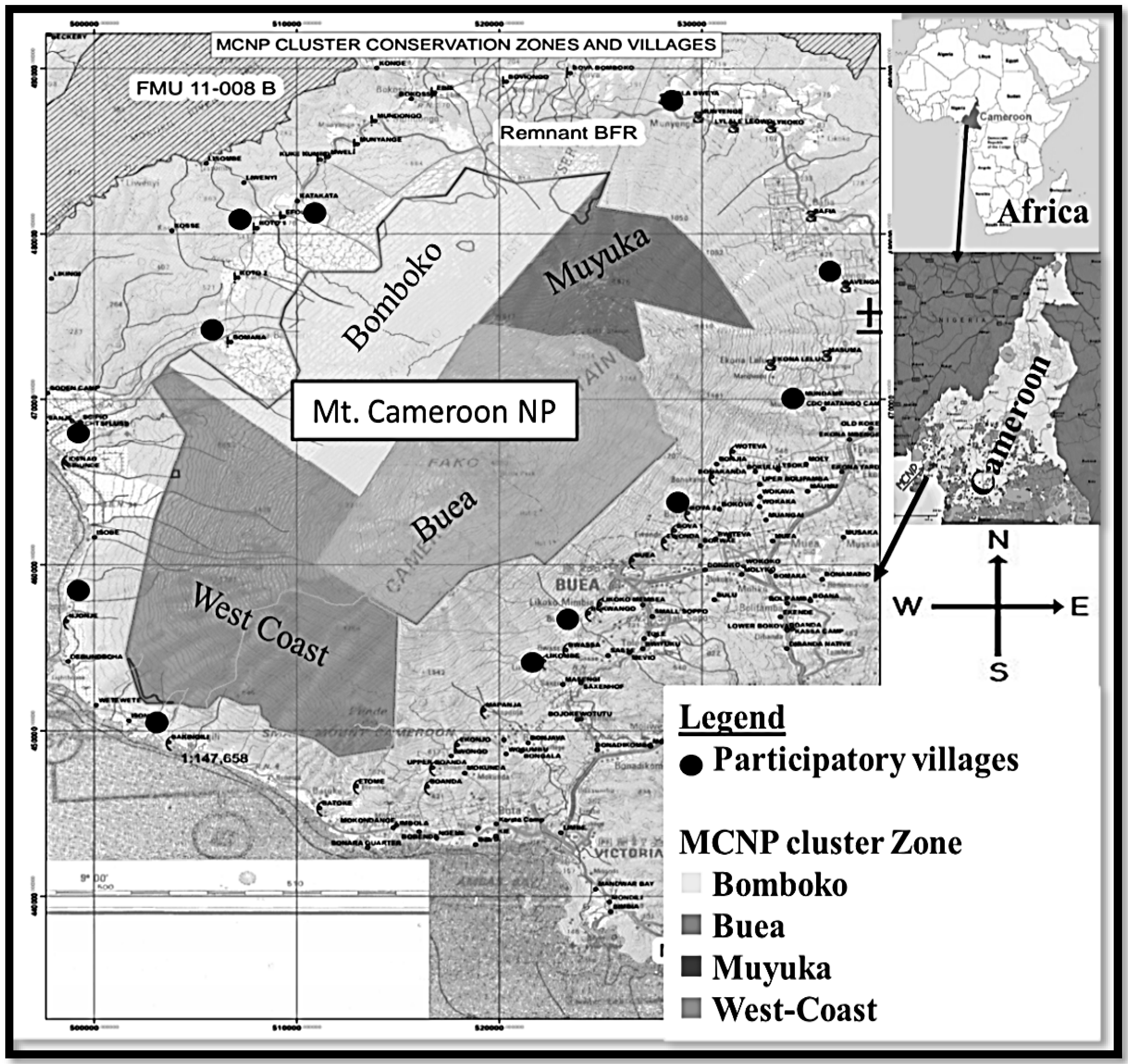

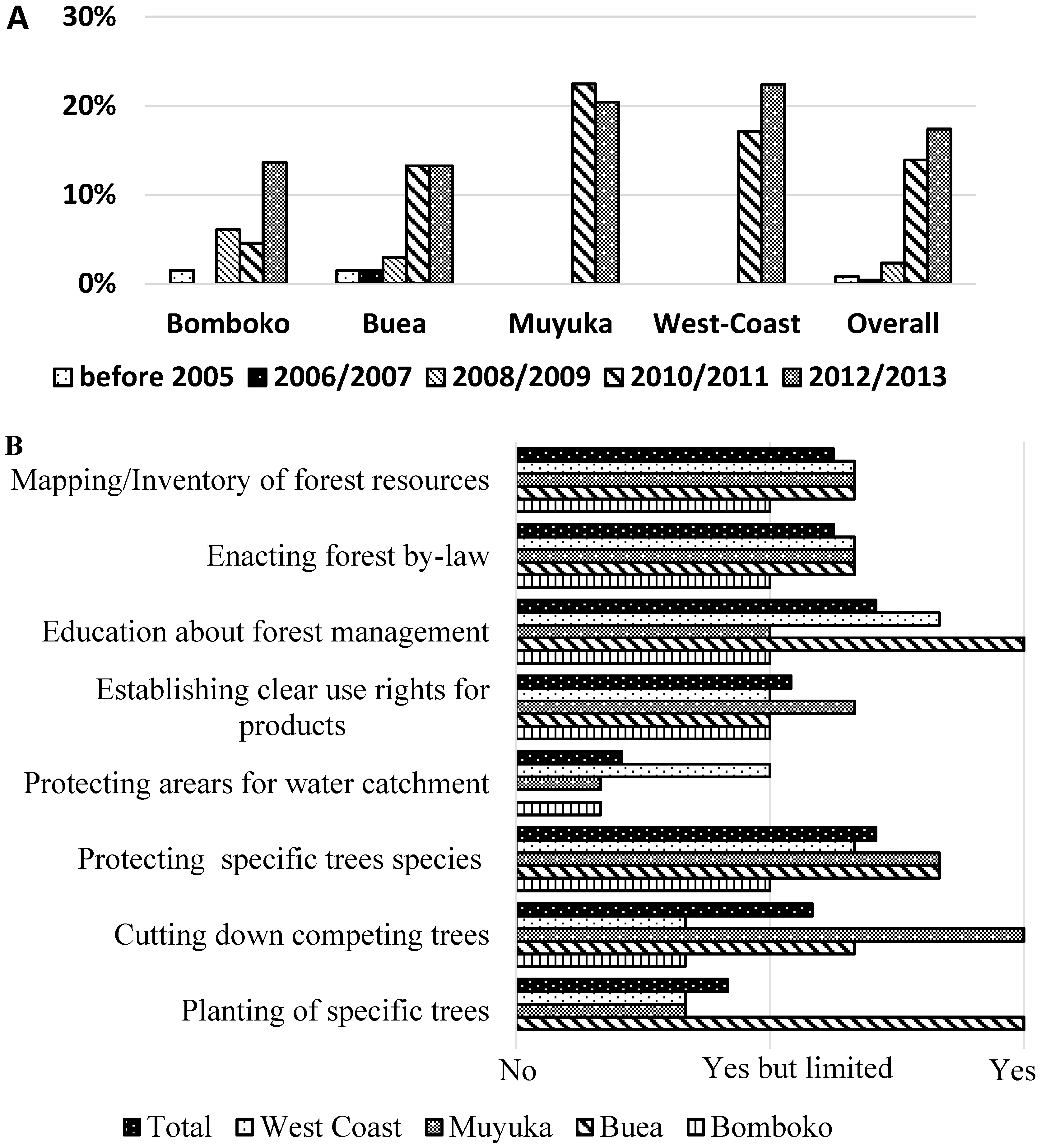
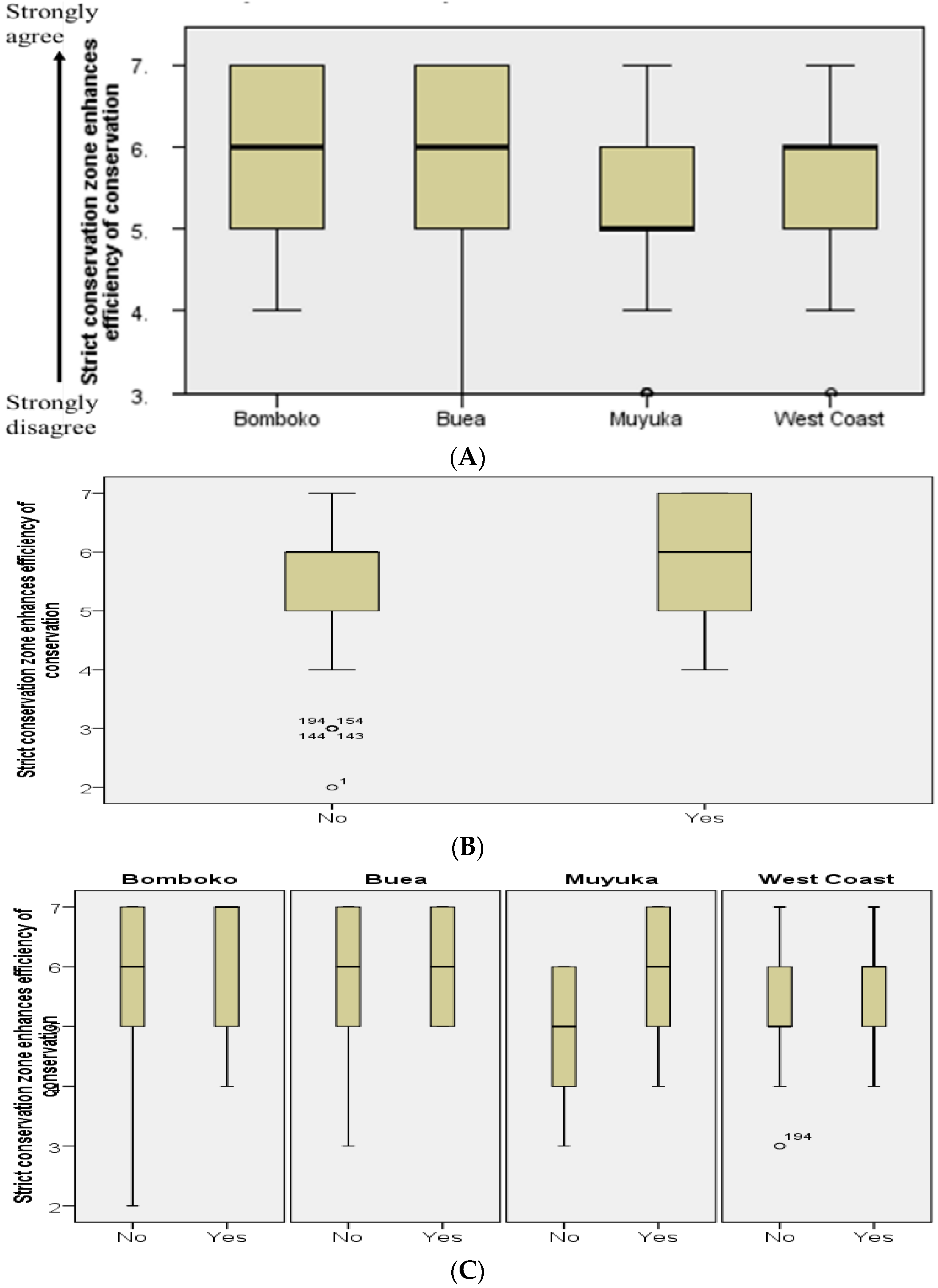


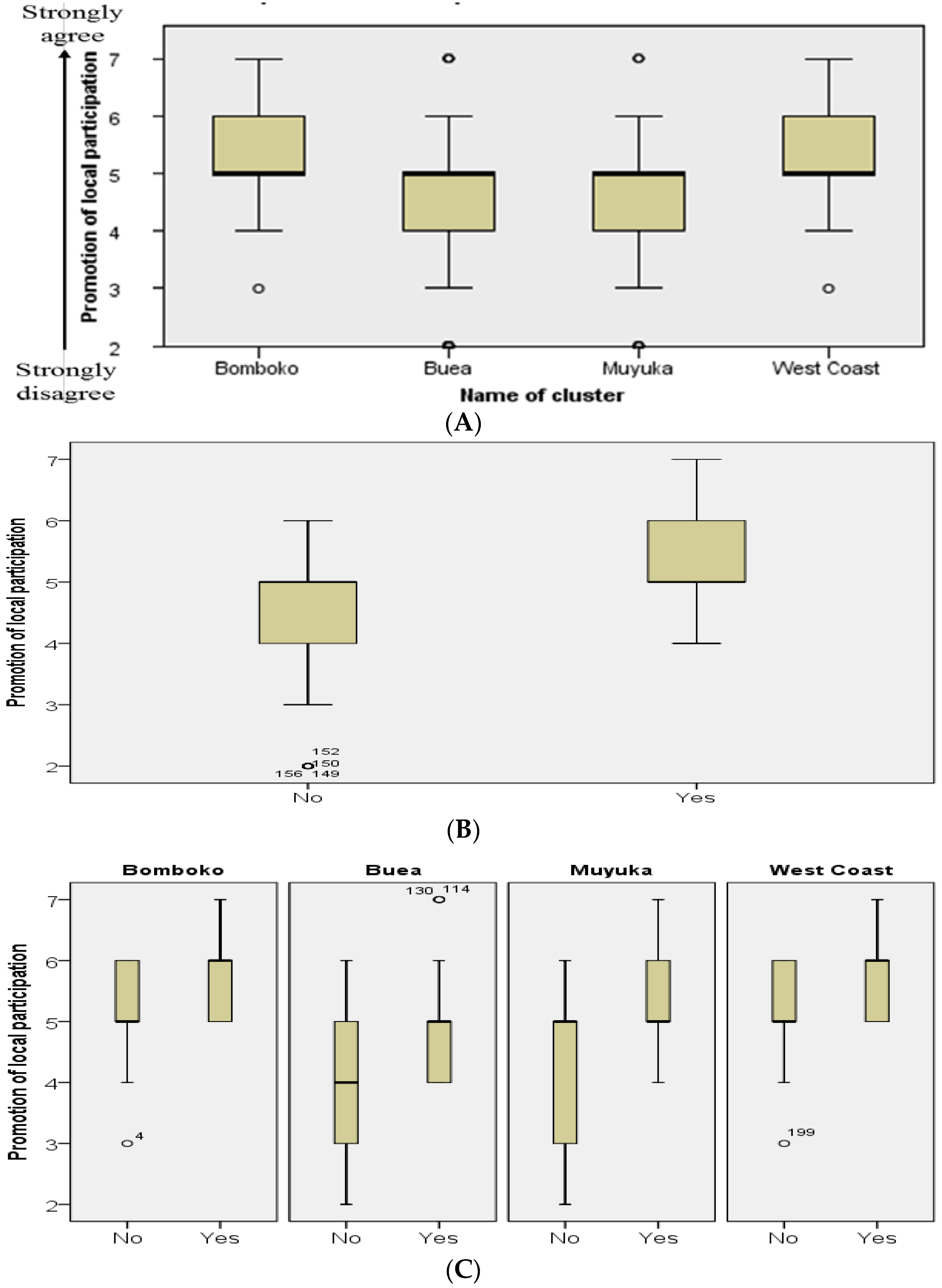
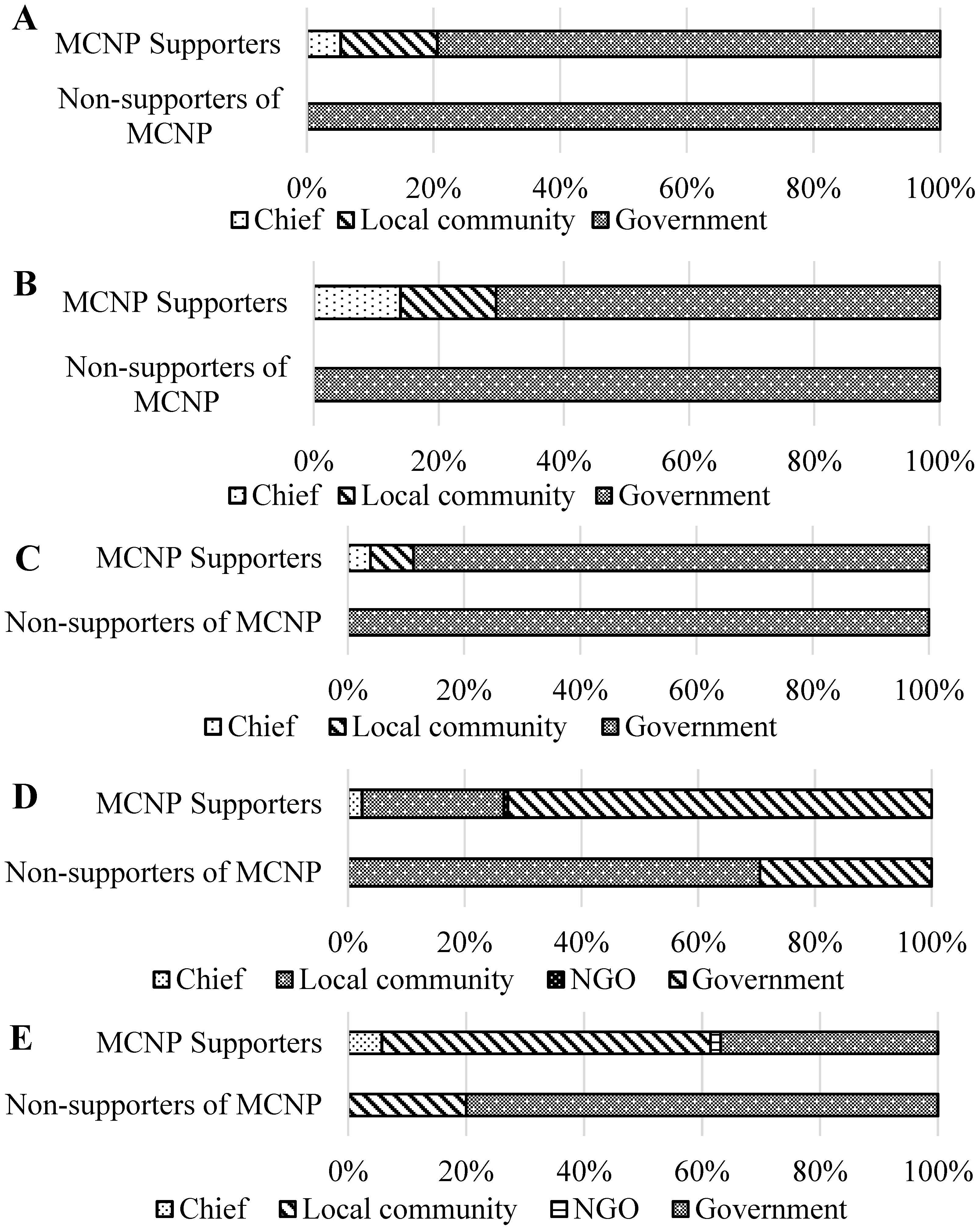
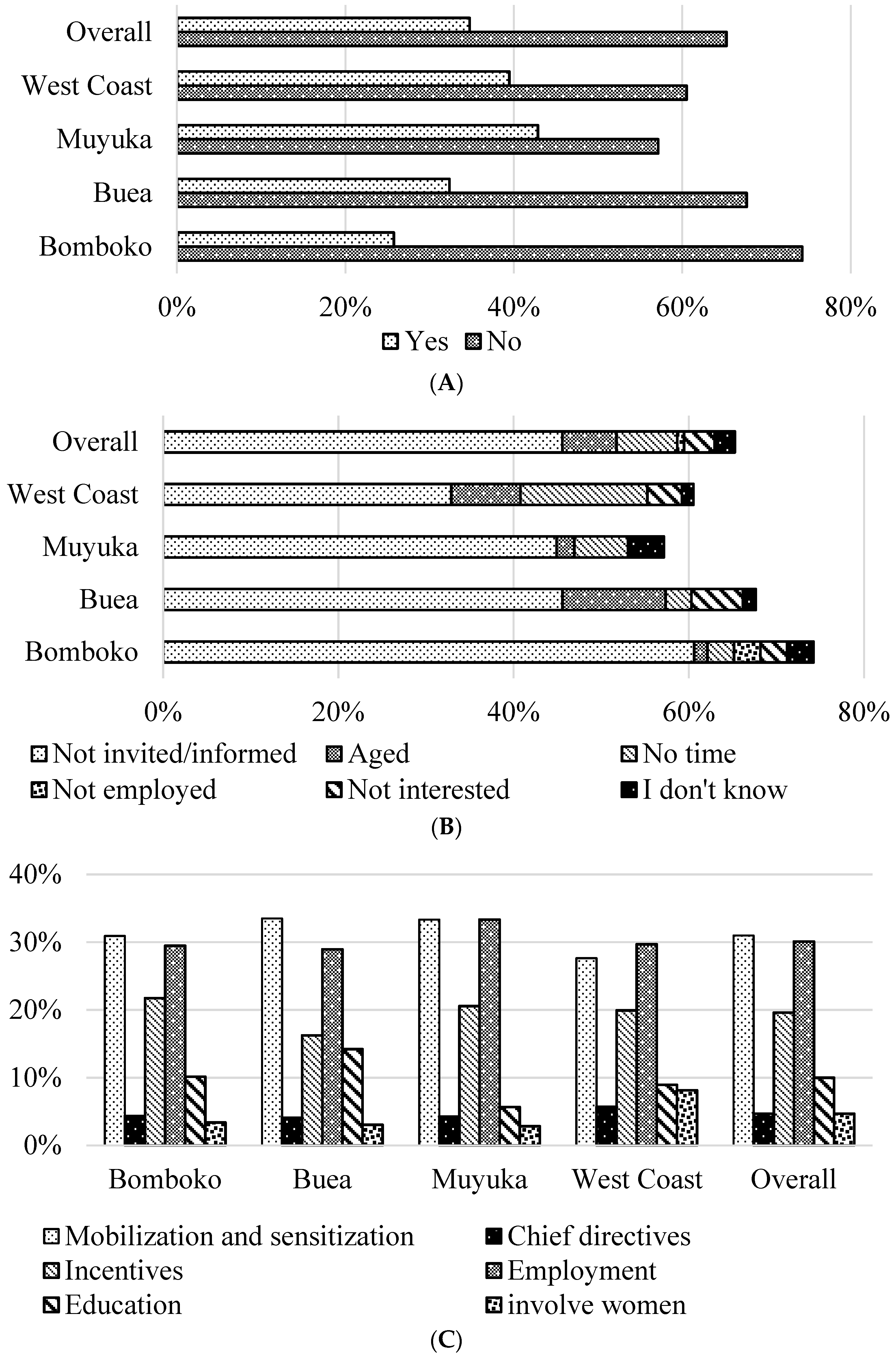

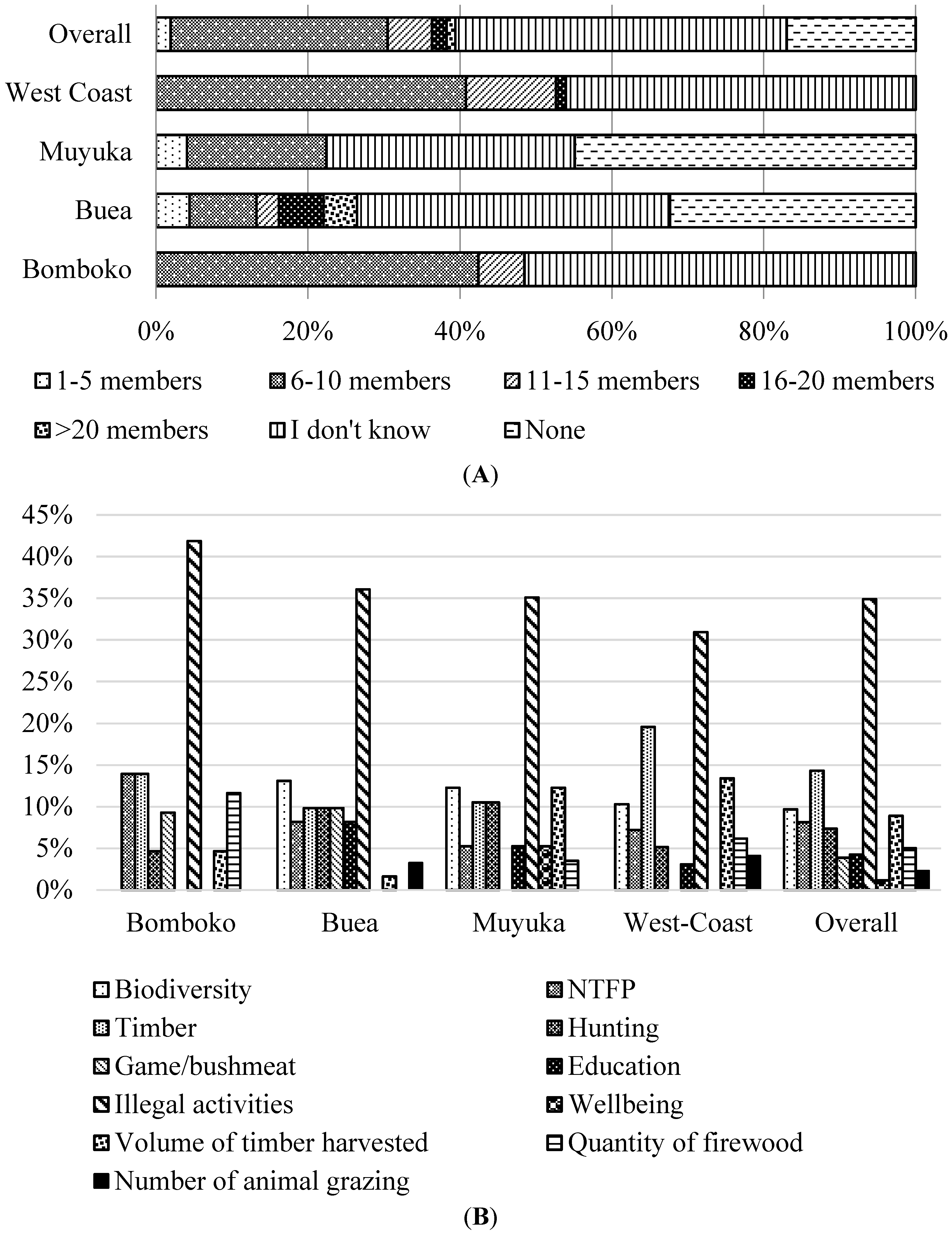

| Location | Density (Number of Trees) dbh < 30 cm | Density (Number of Trees) dbh ≥ 30 cm | Total Density (Number of Trees) | Stock of Fresh Bark (tons) | Annual Quota (tons) R: 5 Year |
|---|---|---|---|---|---|
| National Park | 1.92 (27,984) | 2.01 (28,740) | 3.93 (56,724) | 1,580,701 | 316,140 |
| Support Zone | 1.65 (10,635) | 0.79 (3758) | 2.44 (14,394) | 206,710 | 41,342 |
| Average | 1.79 | 1.40 | 3.19 | ||
| Total | (38,454) | (32,498) | (71,117) | 1,787,411 | 357,482 |
| Total Dry Bark | 893,705 | 178,741 |
| Name of Cluster | Park Villages |
|---|---|
| 1-Buea (Salaried workers) | Upper Boando, Ekonjo, Mapanja, Likombe, Bwassa, Bokwango, Lykoko Membia, Buea village, Ewondo, Bova 1, Bova 2, Bonakanda, Woteva |
| 2-West-Coast (Fishing) | Sanje, Bibunde, Njonji, Bakingili, Etome, Batoke, Lower Boando |
| 3-Muyuka (Hunting) | Mundame, Ekona Lelu, Liola-Buea, Masuma, Bavenga, Bafia, Lykoko, Mile 14, Liliale, Munyenge |
| 4-Bomboko (Timber) | Bova Bomoko, Boviongo, Ebie, Bokoso, Mondongo, Munyange, Mueli, Kukekumbu, Efolofo, Kotto 1, Kotto 2, Bomana |
© 2016 by the authors; licensee MDPI, Basel, Switzerland. This article is an open access article distributed under the terms and conditions of the Creative Commons Attribution (CC-BY) license (http://creativecommons.org/licenses/by/4.0/).
Share and Cite
Awung, N.S.; Marchant, R. Investigating the Role of the Local Community as Co-Managers of the Mount Cameroon National Park Conservation Project. Environments 2016, 3, 36. https://doi.org/10.3390/environments3040036
Awung NS, Marchant R. Investigating the Role of the Local Community as Co-Managers of the Mount Cameroon National Park Conservation Project. Environments. 2016; 3(4):36. https://doi.org/10.3390/environments3040036
Chicago/Turabian StyleAwung, Nvenakeng Suzanne, and Rob Marchant. 2016. "Investigating the Role of the Local Community as Co-Managers of the Mount Cameroon National Park Conservation Project" Environments 3, no. 4: 36. https://doi.org/10.3390/environments3040036
APA StyleAwung, N. S., & Marchant, R. (2016). Investigating the Role of the Local Community as Co-Managers of the Mount Cameroon National Park Conservation Project. Environments, 3(4), 36. https://doi.org/10.3390/environments3040036







